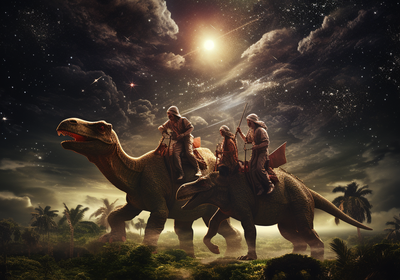-

-
The Discerning Mollusk's Guide to Arts & Ideas
-


ne day, as if out of nowhere, a comet may appear. In fact, it’s an event that’s already happened many times throughout history. Typically, when a comet appears, some people are compelled to follow it. For example, let's say that a comet becomes visible somewhere on the horizon, say in mid-air. Someone, for example one who exports myrrh or recycles gold or incense, could be inclined to think that, if they set off, they could get under it. Their wives might try to dissuade them, but they feel very attracted by the comet and so they set off. There are various tricks a comet does, though, that can be misleading. For example, to a myrrh exporter, it might seem that the comet is going in the opposite direction to the tail, but no, the trail is simply due to the effect of the solar wind, go figure.
But a primitive human, or in this case the myrrh exporter (for simplicity let's call him the myrrhman), who is essentially still quite primitive, could not have known this. So, when the myrrhman, who thought he was being smart, set up his own strategy to anticipate the movement of the comet, setting off not towards the direction where the star was, but towards where the star was going according to his approximate calculations, well, he was very wrong. Of course, day after day he could correct his shot; if he saw the star, let's say in the north but with the tail towards the east, then he walked towards the northwest.
To sum up, the myrrhman looked for the comet in the sky and followed it, trying to anticipate its movement. His goal was to get right under the comet. However, being “under” the comet is a bit subjective, because the universe is not two-dimensional, therefore being “under” or “over” something like a comet depends on your point of view. It's not like if you have a comet at the zenith which means “over” you, then if it falls it will fall on you. Or else you may think you're getting closer to the comet and you didn’t take into account the parallax, which the myrrhman didn't even know existed. Who knows what the myrrhman believed. It is possible that to find oneself under the comet, one may have to walk as far as the North Pole. And a myrrhman, even one riding a fast camel, may have been travelling at ten, twenty miles an hour at most, while the comet has better things to do than just wait for him. Not to mention that if he was trying to anticipate the direction of the comet’s movement based on its tail, then no way, I don't see how he would ever find himself under it. This whole thing sounds a lot like Achilles and the tortoise.
Except if, mistake after mistake, it may also be that they canceled each other out. On one hand, the myrrhman wrongly anticipated the movement of the star, on the other, the parallax existed without his knowledge. The end result may well have been that one morning he myrrhman woke up in a barn and found himself right under the comet. It’s a plausible outcome. And then, out of happiness, he would have gone to drink away the few coins left in his bag joined by a couple of gentlemen he'd met in a tavern. They were loaded with money anyways, since one of them recycled gold and the other one incense. In the end, the three of them got quite drunk and returned to the myrrhman’s barn only to find out that a family of newlyweds had occupied it along with a donkey and a cow. All they could do, then, was to sleep outdoors, though with the comet star directly over them.

Paolo Pergola is the author of Reset (Sagging Meniscus, 2021), Passaggi—avventure di un autostoppista (Rides: The Adventures of a Hitchhiker) (Exorma, 2013) and Attraverso la finestra di Snell (Through Snell’s Window) (Italo Svevo Edizione, 2019). His work has appeared in several Italian literary magazines. He is a member of OPLEPO/Opificio di Letteratura Potenziale (Workshop of Potential Literature), Italy’s equivalent of France’s OULIPO. He lives in Tuscany and works as a zoologist.